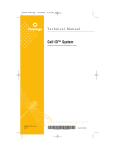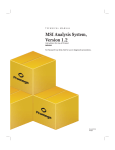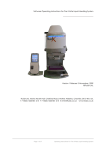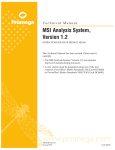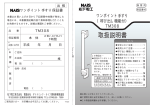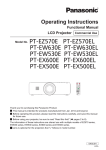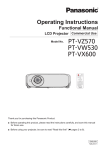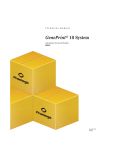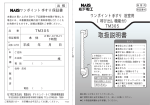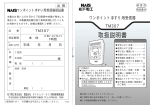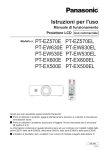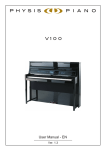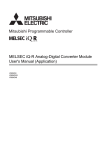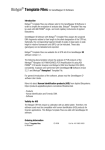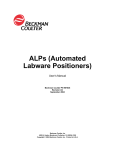Download StemElite™ ID System
Transcript
tm307vfinal.qxp 11/13/2008 1:03 PM Page a Technical Manual StemElite™ ID System INSTRUCTIONS FOR USE OF PRODUCT G9530. PRINTED IN USA. 10/08 Part# TM307 A F 9 T M3 0 7 1 0 0 8 T M3 0 7 tm307vfinal.qxp 11/13/2008 1:03 PM Page 1 StemElite™ ID System All technical literature is available on the Internet at: www.promega.com/tbs/ Please visit the web site to verify that you are using the most current version of this Technical Manual. Please contact Promega Technical Services if you have questions on use of this system. E-mail: [email protected] 1. Description..........................................................................................................2 2. Product Components and Storage Conditions ............................................5 3. Instrumentation Requirements, Software and Accessory Products...................................................................5 4. Matrix Standardization or Spectral Calibration..........................................6 5. Precautions ..........................................................................................................6 6. DNA Sample Preparation ................................................................................7 A. DNA Purification..................................................................................................7 B. DNA Quantitation................................................................................................7 7. Protocols for DNA Amplification Using the StemElite™ ID System ....8 A. Amplification Setup .............................................................................................8 B. Amplification Thermal Cycling........................................................................10 8. Detection of Amplified Fragments Using the Applied Biosystems 3130 or 3130xl Genetic Analyzer and ABI PRISM® 3100 or 3100-Avant Genetic Analyzer with Data Collection Software, Versions 2.0 and 3.0 ...............................11 A. Capillary Electrophoresis Sample Preparation..............................................11 B. Capillary Electrophoresis Instrument Preparation .......................................12 9. Detection of Amplified Fragments Using the ABI PRISM® 310 Genetic Analyzer .............................................................................................14 A. Capillary Electrophoresis Sample Preparation..............................................14 B. Capillary Electrophoresis Instrument Preparation .......................................15 10. Data Analysis....................................................................................................17 A. Downloading Panel and Bin Files ...................................................................17 B. Importing Panel and Bin Files for GeneMapper® ID and GeneMapper® Software.....................................................................................17 C. Creating a Method with GeneMapper® ID and GeneMapper® Software.....................................................................................18 D. Creating a Size Standard ...................................................................................21 E. Processing Data...................................................................................................22 F. Obtaining a Genotype........................................................................................22 G. Controls................................................................................................................23 H. Results ..................................................................................................................23 Promega Corporation · 2800 Woods Hollow Road · Madison, WI 53711-5399 USA Toll Free in USA 800-356-9526 · Phone 608-274-4330 · Fax 608-277-2516 · www.promega.com Printed in USA. 10/08 Part# TM307 Page 1 tm307vfinal.qxp 11/13/2008 1:03 PM Page 2 11. Troubleshooting...............................................................................................27 A. Amplification and Fragment Detection ..........................................................27 B. GeneMapper® and GeneMapper® ID Analysis Software.............................30 12. Appendix ...........................................................................................................33 A. B. C. D. E. F. 1. Additional STR Locus Information .................................................................33 The Internal Lane Standard 600 .......................................................................34 Preparing the StemElite™ ID System Master Mix ........................................35 Composition of Buffers and Solutions ............................................................36 References ............................................................................................................36 Related Products.................................................................................................38 Description Cell line misidentification and cross-contamination have become important concerns for researchers. For example, stem cell lines can become contaminated by the mouse cell line making up the feeder cell layers on which stem cells are propagated. It has been shown that laboratories have invested substantial time and effort researching cell lines that were revealed to be misidentified (1). The situation has prompted the National Institutes of Health to issue a notice to researchers strongly recommending authentication procedures when using cultured cells (2). Genetic profiling can be used as a tool for stem cell line quality assurance, and human cell lines can be authenticated using short tandem repeat (STR) loci (3–5). STR loci consist of short, repetitive sequence elements 3–7 base pairs in length. These repeats are well distributed throughout the human genome and are a rich source of highly polymorphic markers, which can be detected using the polymerase chain reaction. Alleles of STR loci are differentiated by the number of copies of the repeat sequence contained within the amplified region and are distinguished from one another using fluorescence detection, following electrophoretic separation. Early efforts toward genetic characterization of human cell lines used the PowerPlex® 1.2 System. Substantial databases derived using the eight STR loci and Amelogenin locus of the PowerPlex® 1.2 System currently exist (6,7). To support those efforts, we included the PowerPlex® 1.2 System loci in the new StemElite™ ID System(a–d) plus additional loci. The D21S11 locus was included for additional discrimination power. To provide a powerful and complete system for cell line identification we developed the StemElite™ ID System, which contains all reagents required for successful identification and authentication of human stem cell lines and detection of cell line contaminants in a research laboratory. Additionally, we have incorporated a sensitive marker that specifically detects the presence of DNA from the mouse (Mus musculus). This locus has been developed to coamplify with the existing human loci in the primer set provided with this Promega Corporation · 2800 Woods Hollow Road · Madison, WI 53711-5399 USA Toll Free in USA 800-356-9526 · Phone 608-274-4330 · Fax 608-277-2516 · www.promega.com Part# TM307 Page 2 Printed in USA. 10/08 tm307vfinal.qxp 11/13/2008 1:03 PM Page 3 system. The StemElite™ ID System offers the convenience of room-temperature reaction assembly by including a hot-start Taq DNA polymerase system, which is included in a 5X enzyme mix. This allows a simple, one-step addition of Taq DNA polymerase, dNTPs, MgCl2 and reaction buffer necessary for DNA amplification. The StemElite™ ID System allows co-amplification and three-color detection of ten human loci (nine STR loci, Amelogenin for gender identification and one mouse locus), including D21S11, TH01, TPOX, vWA, Amelogenin, CSF1PO, D16S539, D7S820, D13S317, D5S818 and the mouse locus. These loci collectively provide a genetic profile with a random match probability of 1 in 2.92 × 109 (while simultaneously providing detection of a 1% fraction of mouse contaminant in a human cell line). One primer for each of the D21S11, TH01 and mouse loci is labeled with fluorescein (FL); one primer for each of the TPOX, vWA and Amelogenin loci is labeled with carboxytetramethylrhodamine (TMR); and one primer for each of the CSF1PO, D16S539, D7S820, D13S317 and D5S818 loci is labeled with 6-carboxy-4´,5´-dichloro-2´,7´dimethoxy-fluorescein (JOE). The eleven loci are amplified simultaneously in a single tube and analyzed by capillary electrophoresis in a single injection. Figure 1 shows the allele ranges for each locus in the StemElite™ ID System. In addition the StemElite™ ID System contains various controls to provide increased confidence in the genotypes obtained. An internal lane standard (ILS) and allelic ladder are provided for standardization, and a control cell line DNA (9947A) is supplied as a positive control. The ILS is added to every sample after amplification and used within each capillary electrophoresis run to determine TH01 M JOE: TMR: CXR: Size (bp) D5S818 A 100 D21S11 D13S317 vWA D7S820 D16S539 CSF1PO TPOX 200 300 400 A = Amelogenin M = Mouse 7815MA Fluorescein: Figure 1. Allele ranges for the StemElite™ ID System. STR fragments amplified by the StemElite™ ID System are labeled with different dyes and are separated by capillary electrophoresis based on size. A size standard is included in each sample to determine the size of the StemElite™ ID amplified fragments. Fluorescein-labeled loci are shown in dark gray, JOE-labeled loci are shown in gray and TMR-labeled loci are shown in white. The CXR-labeled Internal Lane Standard 600 fragments are represented by black bars. Promega Corporation · 2800 Woods Hollow Road · Madison, WI 53711-5399 USA Toll Free in USA 800-356-9526 · Phone 608-274-4330 · Fax 608-277-2516 · www.promega.com Printed in USA. 10/08 Part# TM307 Page 3 tm307vfinal.qxp 1. 11/13/2008 1:03 PM Page 4 Description (continued) the size of each amplified product. The allelic ladder consists of all major alleles at a particular locus and is used as a standard to positively identify each allele. It is included in each analysis run to control for run-to-run variation. StemElite™ ID allelic ladder information, indicating the size range and repeat numbers for each allele, can be found in Section 12.A. The control 9947A DNA has a known genotype and can be used to verify genotyping accuracy. Figure 2 outlines the StemElite™ ID System protocols in this manual. Briefly, DNA is isolated from cells, quantitated and added to a master mix containing the StemElite™ ID 10X Primer Pair Mix, StemElite™ ID 5X Enzyme Mix and Water, Amplification Grade. PCR is performed, and ILS is added to the amplified product. The alleles are resolved using capillary electrophoresis (CE), and CE data are analyzed using genotyping software and the parameters given on the Promega web site at: www.promega.com/stemeliteid/. This site provides instructions and applications to set the report parameters in the GeneMapper® or GeneMapper® ID software to make genotyping easier and more accurate. This manual contains separate protocols for amplification of STR loci and detection of amplified products. These protocols were tested at Promega. For more information about required instrumentation and software, see Section 3. DNA Sample Preparation Section 6 Amplification Setup Section 7.A Thermal Cycling Section 7.B GeneAmp® PCR System 9700 GeneAmp® PCR System 9600 Instrument Setup and Sample Preparation Applied Biosystems 3130 or 3130xl Genetic Analyzer Section 8 ABI PRISM® 3100 or 3100-Avant Genetic Analyzer with Data Collection Software, Version 2.0 Section 8 ABI PRISM® 310 Genetic Analyzer Section 9 Data Analysis Section 10 GeneMapper® ID Software, Version 3.2 GeneMapper® Software, Version 4.0 Figure 2. An overview of the StemElite™ ID System protocol. Promega Corporation · 2800 Woods Hollow Road · Madison, WI 53711-5399 USA Toll Free in USA 800-356-9526 · Phone 608-274-4330 · Fax 608-277-2516 · www.promega.com Part# TM307 Page 4 Printed in USA. 10/08 tm307vfinal.qxp 2. 11/13/2008 1:03 PM Page 5 Product Components and Storage Conditions Product Size StemElite™ ID System 50 reactions G9530 contains sufficient reagents for 50 reactions of 25μl each. Includes: Cat.# G9530 Pre-amplification Components Box (Blue Label) 250μl 125μl 1.25ml 25μl StemElite™ ID 5X Enzyme Mix StemElite™ ID 10X Primer Pair Mix Water, Amplification Grade 9947A DNA (10ng/μl) Postamplification Components Box (Beige Label) 25μl 150μl StemElite™ ID Allelic Ladder Internal Lane Standard (ILS) 600 Storage Conditions: Store all components at –20°C in a nonfrost-free freezer. The StemElite™ ID 10X Primer Pair Mix, StemElite™ ID Allelic Ladder and Internal Lane Standard 600 are light-sensitive and must be stored protected from light. We strongly recommend that pre-amplification and postamplification reagents be stored and used separately with different pipettes, tube racks, etc. See the expiration date on the product label. 3. Instrumentation Requirements, Software and Accessory Products This manual contains separate protocols for use of the StemElite™ ID System with GeneAmp® PCR system 9700 and 9600 thermal cyclers in addition to protocols to separate amplified products and detect separated material using the capillary electrophoresis instruments: ABI PRISM® 310, 3100 and 3100-Avant Genetic Analyzers and Applied Biosystems 3130 and 3130xl Genetic Analyzers. These protocols were tested at Promega Corporation. Amplification and detection instrumentation may vary. You may need to optimize protocols including cycle number and injection time for each laboratory instrument. Protocols for operation of the fluorescence detection instruments should be obtained from the instrument manufacturer. Matrix standards are required for initial setup of the color separation matrix (Section 4). The matrix standards are sold separately and are available for the ABI PRISM® 310 Genetic Analyzer (PowerPlex® Matrix Standards, 310, Cat.# DG4640) and the ABI PRISM® 3100 and 3100-Avant Genetic Analyzers and Applied Biosystems 3130 and 3130xl Genetic Analyzers (PowerPlex® Matrix Standards, 3100/3130, Cat.# DG4650). Promega Corporation · 2800 Woods Hollow Road · Madison, WI 53711-5399 USA Toll Free in USA 800-356-9526 · Phone 608-274-4330 · Fax 608-277-2516 · www.promega.com Printed in USA. 10/08 Part# TM307 Page 5 tm307vfinal.qxp 4. 11/13/2008 1:03 PM Page 6 Matrix Standardization or Spectral Calibration Proper generation of a matrix file is critical to evaluate multicolor systems with the ABI PRISM® 310, 3100 and 3100-Avant Genetic Analyzers and Applied Biosystems 3130 and 3130xl Genetic Analyzers. A matrix must be generated for each individual instrument. Very high peak heights may not be perfectly separated spectrally, and an allele peak in one color channel can bleed into another color channel. A poor or incorrect matrix will allow this as well. The PowerPlex® Matrix Standards, 310 (Cat.# DG4640), is required for matrix standardization for the ABI PRISM® 310 Genetic Analyzer. For best results, the PowerPlex® Matrix Standards, 3100/3130 (Cat.# DG4650), should not be used to generate a matrix on the ABI PRISM® 310 Genetic Analyzer. The PowerPlex® Matrix Standards, 3100/3130 (Cat.# DG4650), is required for spectral calibration on the ABI PRISM® 3100 and 3100-Avant Genetic Analyzers and Applied Biosystems 3130 and 3130xl Genetic Analyzers. The PowerPlex® Matrix Standards, 310 (Cat.# DG4640), cannot be used to generate a matrix on these instruments. For protocols and additional information on matrix standardization, see the PowerPlex ® Matrix Standards, 310, Technical Bulletin #TBD021, which is supplied with Cat.# DG4640. For protocols and additional information about spectral calibration, see the PowerPlex ® Matrix Standards, 3100/3130, Technical Bulletin #TBD022, which is supplied with Cat.# DG4650. These manuals are available upon request from Promega or online at: www.promega.com/tbs/ 5. Precautions The quality of the purified DNA sample, as well as small changes in buffers, ionic strength, primer concentrations, choice of thermal cycler and thermal cycling conditions, can affect PCR success. We suggest strict adherence to recommended procedures for amplification, as well as electrophoresis and fluorescence detection. PCR-based STR analysis is subject to contamination by very small amounts of nontemplate human DNA. Extreme care should be taken to avoid crosscontamination when preparing sample DNA, handling primer pairs, assembling amplification reactions and analyzing amplification products. Reagents and materials used pre-amplification (StemElite™ ID 5X Enzyme Mix, StemElite™ ID 10X Primer Pair Mix, Amplification Grade Water and 9947A DNA) are provided in a separate box and should be stored separately from those used post-amplification (StemElite™ ID Allelic Ladder and Internal Lane Standard 600). Always include a negative control reaction (i.e., no template) to detect reagent contamination. We highly recommend the use of gloves and aerosolresistant pipette tips (e.g., ART® tips). Promega Corporation · 2800 Woods Hollow Road · Madison, WI 53711-5399 USA Toll Free in USA 800-356-9526 · Phone 608-274-4330 · Fax 608-277-2516 · www.promega.com Part# TM307 Page 6 Printed in USA. 10/08 tm307vfinal.qxp 11/13/2008 1:03 PM Page 7 Some of the reagents used in the analysis of STR products are potentially hazardous and should be handled accordingly. Formamide is an irritant and a teratogen; avoid inhalation and contact with skin. Read the warning label, and take appropriate precautions when handling this substance. Always wear gloves and safety glasses when working with formamide. 6. DNA Sample Preparation 6.A. DNA Purification DNA concentration, purity and integrity are important considerations to ensure success with the StemElite™ ID System. DNA should not be sheared and should be free of contaminating protein and salts. Poor-quality DNA may result in increased background or amplification failure. Too much or too little DNA in the reaction can cause amplification failure, which can be manifested in several ways: complete lack of amplification of all loci or dropout of all or subsets of the alleles. Commercially available DNA purification systems such as the MagneSil® Genomic, Fixed Tissue DNA Purification System (Cat.# MD1490), Wizard® SV Genomic DNA Purification System (Cat.# A2360), Wizard® Genomic DNA Purification System (Cat.# A1620) and Maxwell® 16 Cell LEV DNA Purification Kit (Cat.# AS1140) produce DNA of sufficient quality for the StemElite™ ID System. These systems yield clean DNA for STR analysis easily and efficiently. The MagneSil® Resin eliminates PCR inhibitors and contaminants frequently encountered in DNA samples. DNA should be stored in a low-EDTA TE buffer (pH 8.0). We recommend TE–4 buffer (10mM Tris-HCl, 0.1mM EDTA [pH 8.0]). High salt concentration or altered pH can affect amplification. If the DNA template is stored in TE buffer that is not pH 8.0 or contains a higher EDTA concentration, the DNA volume should not exceed 20% of the total reaction volume. Carryover of K+, Na+, Mg2+ or EDTA can negatively affect PCR. 6.B. DNA Quantitation We recommend quantitating the DNA prior to use in the StemElite™ ID System, as either too much or too little DNA can cause reactions to fail. Use the recommended amount of template DNA. Stochastic effects, which can cause imbalance, can occur when amplifying low amounts of template. Amplifying high amounts of template can result in less amplification of larger STR loci. Absorbance readings at 260nm can be used to estimate DNA concentration, where 1AU = 50μg of double-stranded DNA/ml. The Quant-iT™ PicoGreen® dsDNA quantitation assay (Invitrogen) can also be used. Use 2ng of DNA in each StemElite™ ID System reaction. Note: As little as 20pg of mouse DNA is detectable in the StemElite™ ID System. Promega Corporation · 2800 Woods Hollow Road · Madison, WI 53711-5399 USA Toll Free in USA 800-356-9526 · Phone 608-274-4330 · Fax 608-277-2516 · www.promega.com Printed in USA. 10/08 Part# TM307 Page 7 tm307vfinal.qxp 11/13/2008 1:03 PM Page 8 6.B. DNA Quantitation (continued) ! If you are not using one of these kits for DNA purification, we recommend measuring absorbance of the DNA sample at 260nm and 280nm to confirm that the DNA is sufficiently free of impurities. High-quality DNA has a typical A260/A280 ratio of 1.8. The presence of impurities in the DNA sample can cause amplification failure. Note that DNA concentration can be overestimated by spectrophotometry if the A260/A280 ratio is low. ! Cross-contamination with another template or previously amplified DNA can lead to extra peaks in the sample. Use aerosol-resistant pipette tips, and change gloves regularly when working with the StemElite™ ID System. 7. Protocols for DNA Amplification Using the StemElite™ ID System Materials to Be Supplied by the User • GeneAmp® PCR System 9600 or 9700 thermal cyclers (Applied Biosystems) • 0.2ml thin-walled microcentrifuge tubes, MicroAmp® optical 96-well reaction plate or 0.2ml MicroAmp® 8-strip reaction tubes (Applied Biosystems) • 1.5ml amber-colored microcentrifuge tubes (Fisher Cat.# 05-402-26) • aerosol-resistant pipette tips The StemElite™ ID System has been optimized to amplify 2ng of template DNA in a 25μl reaction using the protocols detailed below. Preferential amplification of smaller loci can occur. Expect to see high peak heights for the smaller loci and relatively lower peak heights for the larger loci if more than the recommended amount of template is used. Reduce the amount of template DNA or number of PCR cycles to correct this. The StemElite™ ID System is optimized for the GeneAmp® PCR system 9700 thermal cycler. An amplification protocol for the GeneAmp® PCR system 9600 thermal cycler is also provided. 7.A. Amplification Setup ! Keep all pre-amplification and postamplification reagents in separate rooms. Prepare amplification reactions in a room dedicated to reaction setup. Use equipment and supplies dedicated to amplification setup. ! Cross-contamination with another template or previously amplified DNA can lead to extra peaks in the sample. Use aerosol-resistant pipette tips, and change gloves regularly. 1. Thaw the StemElite™ ID 5X Enzyme Mix and StemElite™ ID 10X Primer Pair Mix. Note: Vortex reagents for 15 seconds before each use. Do not centrifuge the 10X Primer Pair Mix, as this may cause the primers to be concentrated at the bottom of the tube. Promega Corporation · 2800 Woods Hollow Road · Madison, WI 53711-5399 USA Toll Free in USA 800-356-9526 · Phone 608-274-4330 · Fax 608-277-2516 · www.promega.com Part# TM307 Page 8 Printed in USA. 10/08 tm307vfinal.qxp 11/13/2008 1:03 PM Page 9 2. Determine the number of reactions to be set up. This should include positive and negative control reactions. Add 1 or 2 reactions to this number to compensate for pipetting error. While this approach does waste a small amount of each reagent, it ensures that you will have enough PCR master mix for all samples. It also ensures that each reaction contains the same master mix. 3. Place one clean, 0.2ml reaction tube for each reaction into a rack, and label appropriately. Alternatively, use a MicroAmp® plate or 0.2ml MicroAmp® 8-strip reaction tubes, and label appropriately. 4. Add the final volume of each reagent listed in Table 1 into a sterile, 1.5ml amber-colored tube. Mix gently. A worksheet to calculate reagent volumes for a multiple-reaction StemElite™ ID master mix can be found in Section 12.C. Table 1. PCR Master Mix for the StemElite™ ID System. PCR Master Mix Component StemElite™ ID 5X Enzyme Mix StemElite™ ID 10X Primer Pair Mix Water, Amplification Grade template DNA (2ng)1 1The Volume Per Reaction 5.0μl 2.5μl to a final volume of 25.0μl up to 17.5μl template DNA will be added at Step 7. Amplification of >2ng of DNA template results in an imbalance in peak heights from locus to locus in the resulting data. The smaller loci show greater amplification yield than the larger loci. Reducing the number of cycles in the amplification program by 2–4 cycles (i.e., 10/20 or 10/18 cycling) can improve locus-to-locus balance. 5. Vortex the PCR master mix for 5–10 seconds. 6. Pipet PCR master mix into each reaction tube. 7. Pipet the template DNA (2ng) for each sample into the respective tube containing PCR master mix. 8. For the positive amplification control, dilute the 9947A DNA to 2ng in the desired template DNA volume. Pipet 2ng of the diluted DNA into a reaction tube containing the PCR master mix. 9. Optional: If including a positive amplification control for mouse DNA, dilute the Mouse Genomic DNA (Cat.# G3091; must be purchased separately) to 100pg in the desired template DNA volume. Pipet 100pg of the diluted DNA into a reaction tube containing the PCR master mix. 10. For the negative amplification control, pipet Water, Amplification Grade, (instead of template DNA) into a reaction tube containing the PCR master mix. Promega Corporation · 2800 Woods Hollow Road · Madison, WI 53711-5399 USA Toll Free in USA 800-356-9526 · Phone 608-274-4330 · Fax 608-277-2516 · www.promega.com Printed in USA. 10/08 Part# TM307 Page 9 tm307vfinal.qxp 11/13/2008 1:03 PM Page 10 7.B. Amplification Thermal Cycling This manual contains protocols for use of the StemElite™ ID System with the GeneAmp® PCR system 9600 and 9700 thermal cyclers. We have not tested other reaction tubes, plates or thermal cyclers. For information about other thermal cyclers, please contact Promega Technical Services by e-mail: [email protected] Amplification and detection instrumentation may vary. You may need to optimize protocols including cycle number and injection time (or loading volume) for each laboratory instrument. Testing at Promega Corporation shows that 10/22 cycles work well for 2ng of purified DNA templates. For higher amounts of input DNA or to decrease sensitivity, fewer cycles, such as 10/16, 10/18 or 10/20, should be evaluated. In-house validation should be performed. 1. Place the tubes or MicroAmp® plate in the thermal cycler. 2. Select and run a recommended protocol. The preferred protocols for use with the GeneAmp® PCR system 9700 and 9600 thermal cyclers are provided below. 3. After completion of the thermal cycling protocol, store the samples at –20°C in a light-protected box. Note: Storage of amplified samples at 4°C or higher may produce degradation products. Protocol for the GeneAmp® PCR System 9700 Thermal Cycler Protocol for the GeneAmp® PCR System 9600 Thermal Cycler 96°C for 2 minutes, then: 96°C for 2 minutes, then: ramp 100% to 94°C for 30 seconds ramp 29% to 60°C for 30 seconds ramp 23% to 70°C for 45 seconds for 10 cycles, then: 94°C for 30 seconds, then: ramp 100% to 90°C for 30 seconds ramp 29% to 60°C for 30 seconds ramp 23% to 70°C for 45 seconds for 22 cycles, then: ramp 60 seconds to 60°C (hold for 30 seconds) ramp 50 seconds to 70°C (hold for 45 seconds) for 10 cycles, then: 90°C for 30 seconds, then: ramp 60 seconds to 60°C (hold for 30 seconds) ramp 50 seconds to 70°C (hold for 45 seconds) 60°C for 30 minutes for 22 cycles, then: 4°C soak 60°C for 30 minutes 4°C soak Promega Corporation · 2800 Woods Hollow Road · Madison, WI 53711-5399 USA Toll Free in USA 800-356-9526 · Phone 608-274-4330 · Fax 608-277-2516 · www.promega.com Part# TM307 Page 10 Printed in USA. 10/08 tm307vfinal.qxp 8. 11/13/2008 1:03 PM Page 11 Detection of Amplified Fragments Using the Applied Biosystems 3130 or 3130xl Genetic Analyzer and ABI PRISM® 3100 or 3100-Avant Genetic Analyzer with Data Collection Software, Versions 2.0 and 3.0 Materials to Be Supplied by the User • 95°C dry heating block, water bath or thermal cycler • crushed ice or ice-water bath • aerosol-resistant pipette tips • 3100 or 3130 capillary array, 36cm • performance optimized polymer 4 (POP-4™) for the 3100 or 3130 • 10X Genetic Analyzer buffer with EDTA • MicroAmp® optical 96-well plate and septa • Hi-Di™ formamide (Applied Biosystems Cat.# 4311320) • PowerPlex® Matrix Standards, 3100/3130 (Cat.# DG4650) ! The quality of the formamide is critical. Use Hi-Di™ formamide with a conductivity less than 100μS/cm. Freeze formamide in aliquots at –20°C. Multiple freeze-thaw cycles or long-term storage at 4°C may cause a breakdown of the formamide. Formamide with a conductivity greater than 100μS/cm may contain ions that compete with DNA during injection. This results in lower peak heights in the resulting data and reduced sensitivity. A longer injection time may not increase the signal. ! Caution: Formamide is an irritant and a teratogen; avoid inhalation and contact with skin. Read the warning label, and take appropriate precautions when handling this substance. Always wear gloves and safety glasses when working with formamide. 8.A. Capillary Electrophoresis Sample Preparation 1. Prepare a loading cocktail by combining and mixing the internal lane standard and Hi-Di™ formamide as follows: [(0.5μl ILS 600) × (# injections)] + [(9.5μl Hi-Di™ formamide) × (# injections)] Note: The volume of internal lane standard used in the loading cocktail can be increased or decreased to adjust the intensity of the size standard peaks in the resulting data. The optimal peak height for the 100-base fragment of the internal lane standard is 500–1,000RFU. If the peak heights are too low, we recommend altering the formamide/internal lane standard mix to contain 1.0μl of ILS 600 and 9.0μl of Hi-Di™ formamide. If the peak heights are too high, we recommend altering the loading cocktail to contain 0.25μl of ILS 600 and 9.75μl of formamide. 2. Vortex for 10–15 seconds. 3. Pipet 10μl of formamide/internal lane standard mix into each well. Promega Corporation · 2800 Woods Hollow Road · Madison, WI 53711-5399 USA Toll Free in USA 800-356-9526 · Phone 608-274-4330 · Fax 608-277-2516 · www.promega.com Printed in USA. 10/08 Part# TM307 Page 11 tm307vfinal.qxp 11/13/2008 1:03 PM Page 12 8.A. Capillary Electrophoresis Sample Preparation (continued) 4. Add 1μl of amplified sample (or 1μl of StemElite™ ID Allelic Ladder). Cover wells with appropriate septa. ! Note: Instrument detection limits vary; therefore, injection time or the amount of product mixed with loading cocktail may need to be increased or decreased. Use the “Module Manager” in the data collection software to modify the injection time or voltage in the run module. Alternatively, use less DNA template in the amplification reactions or reduce the number of cycles in the amplification program by 2–4 cycles to achieve the desired signal intensity. 5. Centrifuge the plate briefly to remove air bubbles from the wells if necessary. 6. Denature samples at 95°C for 3 minutes, then immediately chill on crushed ice or in an ice-water bath for 3 minutes. ! Note: Denatured-sample plates should be run within 24 hours of setup. Long-term storage of amplified sample in formamide can result in DNA degradation. Sample preparation can be repeated with fresh formamide by repeating Steps 1–6. 8.B. Capillary Electrophoresis Instrument Preparation Refer to the instrument user’s manual for instructions on cleaning, installing the capillary array, performing a spatial calibration and adding polymer. Follow the manufacturer’s recommendations for polymer storage and shelf life. Polymer stored at room temperature for more than 1 week can result in broad or split peaks or extra peaks visible in one or all of the color channels. Maintain the instrumentation on a daily or weekly basis as recommended by the manufacturer for optimal results and fewer instrument-related artifacts. Contaminants in the water used with the instrument or to dilute the 10X Genetic Analyzer buffer may generate peaks in the blue and green dye colors. Use autoclaved water. Analyze the samples as described in the user’s manual for the ABI PRISM® 3100 or 3100-Avant Genetic Analyzer with data collection software, version 2.0, and the Applied Biosystems 3130 or 3130xl Genetic Analyzer with the following exceptions. 1. In the Module Manager, select “New”. Select “Regular” in the Type dropdown list, and select “HIDFragmentAnalysis36_POP4” in the Template drop-down list. Confirm that the injection time is 5 seconds and the injection voltage is 3kV. Lengthen the run time to 2,000 seconds. Give a descriptive name to your run module, and select “OK”. Note: Sensitivities of instruments may vary. The injection time and voltage may be adjusted in the Module Manager. A suggested range for the injection time is 3–22 seconds and for the injection voltage is 1–3kV. 2. In the Protocol Manager, select “New”. Type a name for your protocol. Promega Corporation · 2800 Woods Hollow Road · Madison, WI 53711-5399 USA Toll Free in USA 800-356-9526 · Phone 608-274-4330 · Fax 608-277-2516 · www.promega.com Part# TM307 Page 12 Printed in USA. 10/08 tm307vfinal.qxp 11/13/2008 1:03 PM Page 13 Select “Regular” in the Type drop-down list, and select the run module you created in the previous step in the Run Module drop-down list. Lastly, select “F” in the Dye-Set drop-down list. Select “OK”. 3. In the Plate Manager, create a new plate record as described in the instrument user’s manual. In the dialog box that appears, select “GeneMapper-Generic” in the Application drop-down list, and select the appropriate plate type (96-well). Add entries in the owner and operator windows, and select “OK”. Note: If autoanalysis of sample data is desired, refer to the instrument user’s manual for instructions. 4. In the GeneMapper® plate record, enter sample names in the appropriate cells. Scroll to the right. In the “Results group 1” column, select the desired results group. In the “Instrument Protocol 1” column, select the protocol you created in Step 2. Be sure this information is present for each row that contains a sample name. Select “OK”. Note: To create a new results group, select “New” in the drop-down menu in the results group column. Select the General tab, and enter a name. Select the Analysis tab, and select “GeneMapper-Generic” in the Analysis type drop-down list. 5. Place samples in the instrument, and close the instrument doors. 6. In the spectral viewer, confirm that dye set F is active, and set the correct active calibration for dye set F. 7. In the run scheduler, locate the plate record that you just created in Steps 3 and 4, and click once on the name to highlight it. Once the plate record is highlighted, click the plate graphic that corresponds to the plate on the autosampler that contains your amplified samples. When the plate record is linked to the plate, the plate graphic will change from yellow to green, and the green Run Instrument arrow becomes enabled. 8. Click on the green Run Instrument arrow on the toolbar to start the sample run. 9. Monitor electrophoresis by observing the run, view, array or capillaries viewer window in the data collection software. Each injection will take approximately 45 minutes. Note: If peaks are low or absent, the sample can be reinjected with increased injection time and/or voltage. If the ILS 600 is also affected, check the laser power. Promega Corporation · 2800 Woods Hollow Road · Madison, WI 53711-5399 USA Toll Free in USA 800-356-9526 · Phone 608-274-4330 · Fax 608-277-2516 · www.promega.com Printed in USA. 10/08 Part# TM307 Page 13 tm307vfinal.qxp 9. 11/13/2008 1:03 PM Page 14 Detection of Amplified Fragments Using the ABI PRISM® 310 Genetic Analyzer Materials to Be Supplied by the User • 95°C dry heating block, water bath or thermal cycler • 310 capillaries, 47cm × 50μm • performance optimized polymer 4 (POP-4™) • glass syringe (1ml) • 10X Genetic Analyzer buffer with EDTA • sample tubes and septa • aerosol-resistant pipette tips • Hi-Di™ formamide (Applied Biosystems Cat.# 4311320) • PowerPlex® Matrix Standards, 310 (Cat.# DG4640) • crushed ice or ice-water bath ! The quality of the formamide is critical. Use Hi-Di™ formamide with a conductivity less than 100μS/cm. Freeze formamide in aliquots at –20°C. Multiple freeze-thaw cycles or long-term storage at 4°C may cause a breakdown of the formamide. Formamide with a conductivity greater than 100μS/cm may contain ions that compete with DNA during injection. This results in lower peak heights in the resulting data and reduced sensitivity. A longer injection time may not increase the signal. ! Caution: Formamide is an irritant and a teratogen; avoid inhalation and contact with skin. Read the warning label, and take appropriate precautions when handling this substance. Always wear gloves and safety glasses when working with formamide. 9.A. Capillary Electrophoresis Sample Preparation 1. Prepare a loading cocktail by combining the Internal Lane Standard 600 (ILS 600) and Hi-Di™ formamide as follows: [(1.0μl ILS 600) × (# injections)] + [(24.0μl Hi-Di™ formamide) × (# injections)] Note: The volume of internal lane standard used in the loading cocktail can be increased or decreased to adjust the intensity of the size standard peaks. The optimal peak height for the 100-base fragment of the internal lane standard is 500–1,000RFU. If the peak heights are too low we recommend altering the ILS/formamide mix to 1.5μl of ILS 600 and 24μl of Hi-Di™ formamide. If the peak heights are too high, we recommend altering the loading cocktail to contain 0.5μl of ILS 600 and 24.5μl of Hi-Di™ formamide. 2. Vortex for 10–15 seconds. Promega Corporation · 2800 Woods Hollow Road · Madison, WI 53711-5399 USA Toll Free in USA 800-356-9526 · Phone 608-274-4330 · Fax 608-277-2516 · www.promega.com Part# TM307 Page 14 Printed in USA. 10/08 tm307vfinal.qxp 11/13/2008 1:03 PM Page 15 3. Combine 25μl of the prepared loading cocktail and 1μl of amplified sample (or 1μl of StemElite™ ID Allelic Ladder). Note: Instrument detection limits vary; therefore, injection time or the amount of product mixed with loading cocktail may need to be increased or decreased. Alternatively, use less DNA template in the amplification reactions or reduce the number of cycles in the amplification program by 2–4 cycles to achieve the desired signal intensity. 4. Centrifuge the sample tubes briefly to remove air bubbles from the wells if necessary. 5. Denature the samples and ladder by heating at 95°C for 3 minutes, and immediately chill on crushed ice or in an ice-water bath for 3 minutes. Note: Improper denaturation can result in extra peaks. 6. Assemble the tubes in the appropriate autosampler tray (48- or 96-tube). 7. Place the autosampler tray in the instrument, and close the instrument doors. ! Note: Denatured sample plates should be run within 24 hours of setup. Long-term storage of amplified sample in formamide can result in DNA degradation. Sample preparation can be repeated with fresh formamide. 9.B. Capillary Electrophoresis Instrument Preparation Refer to the instrument user’s manual for instructions on cleaning the pump block, installing the capillary, calibrating the autosampler and adding polymer to the syringe. Follow the manufacturer’s recommendations for polymer storage and shelf life. Polymer stored at room temperature for more than 1 week can result in broad or split peaks or extra peaks visible in one or all of the color channels. Maintain the instrumentation on a daily or weekly basis as recommended by the manufacturer for optimal results and fewer instrumentrelated artifacts. Contaminants in the water used with the instrument or to dilute the 10X Genetic Analyzer buffer may generate peaks in the blue and green dye colors. Use autoclaved water. 1. Open the ABI PRISM® 310 data collection software. 2. Prepare a GeneScan® sample sheet as described in the ABI PRISM® 310 Genetic Analyzer user’s manual. Enter the appropriate sample information in the “sample info” column. 3. Create a new GeneScan® injection list. Select the appropriate sample sheet by using the pull-down menu. Promega Corporation · 2800 Woods Hollow Road · Madison, WI 53711-5399 USA Toll Free in USA 800-356-9526 · Phone 608-274-4330 · Fax 608-277-2516 · www.promega.com Printed in USA. 10/08 Part# TM307 Page 15 tm307vfinal.qxp 11/13/2008 1:03 PM Page 16 9.B. Capillary Electrophoresis Instrument Preparation (continued) 4. Select the “GS STR POP4 (1ml) A” Module using the pull-down menu. Change the injection time to 3 seconds and the run time to 30 minutes. Keep the settings for the remaining parameters as shown below: Inj. Secs: 3 Inj. kV: 15.0 Run kV: 15.0 Run °C: 60 Run Time: 30 ! You may need to optimize the injection time for individual instruments. Injection times of 2–5 seconds are suggested for reactions that contain 2ng of template DNA. Note: Migration of fragments can vary slightly over the course of a long ABI PRISM® 310 Genetic Analyzer run. This may be due to changes in temperature or changes in the column. When analyzing many samples, injections of the allelic ladder at different times throughout the run can aid in accurately genotyping the samples. 5. Select the appropriate matrix file. 6. To analyze the data automatically, select the auto analyze checkbox and the appropriate analysis parameters and size standard. Refer to the ABI PRISM® 310 Genetic Analyzer user’s manual for specific information on these options. 7. After loading the sample tray and closing the doors, select “Run” to start the capillary electrophoresis system. 8. Monitor the electrophoresis by observing the raw data and status windows. Each sample will take approximately 40 minutes for syringe pumping, sample injection and sample electrophoresis. Promega Corporation · 2800 Woods Hollow Road · Madison, WI 53711-5399 USA Toll Free in USA 800-356-9526 · Phone 608-274-4330 · Fax 608-277-2516 · www.promega.com Part# TM307 Page 16 Printed in USA. 10/08 tm307vfinal.qxp 11/13/2008 1:03 PM Page 17 10. Data Analysis To interpret data generated using the StemElite™ ID System, you will need GeneMapper® or GeneMapper® ID software. To facilitate analysis of data generated with the StemElite™ ID System, we have created panel and bin files to allow automatic assignment of genotypes using GeneMapper® ID software, version 3.2, and GeneMapper® software, version 4.0. We recommend that users of GeneMapper® ID software, version 3.2, complete the Applied Biosystems GeneMapper® ID software human identification analysis tutorial to familiarize themselves with the proper operation of the software. For GeneMapper® ID software, version 3.1 users, we recommend upgrading to version 3.2. 10.A. Downloading Panel and Bin Files 1. Download the panel and bin files for use with GeneMapper® ID and GeneMapper® software from the Promega web site: www.promega.com/stemeliteid/ 2. Enter your contact information, and select the appropriate analysis software. Select “Submit”. 3. Select the “StemElite ID Panels and Bins Set” link, and save the zipped file to your computer. 4. Open the files using the Windows® WinZip program, and save the unzipped files to a known location on your computer. 10.B. Importing Panel and Bin Files for GeneMapper® ID and GeneMapper® Software These instructions loosely follow the Applied Biosystems GeneMapper® ID software tutorial, pages 1–4, and the GeneMapper ® Software Version 4.0 Microsatellite Analysis Getting Started Guide. 1. Open the GeneMapper® ID software, version 3.2, or GeneMapper® software, version 4.0. 2. Select ”Tools”, then “Panel Manager”. 3. Highlight the Panel Manager icon in the upper left tile (navigation pane). 4. Select “File”, then “Import Panels”. 5. Navigate to the panel and bin files saved in Section 10.A. Select “StemElite_ID_Panels_1.0.txt”. Select “Import”. 6. In the navigation pane, highlight the StemElite_ID_Panels_1.0.txt folder that you just imported. 7. Select “File”, then “Import Bin Set”. 8. Navigate to the panel and bin files. Select “StemElite_ID_Bins_1.0.txt”, then “Import”. Promega Corporation · 2800 Woods Hollow Road · Madison, WI 53711-5399 USA Toll Free in USA 800-356-9526 · Phone 608-274-4330 · Fax 608-277-2516 · www.promega.com Printed in USA. 10/08 Part# TM307 Page 17 tm307vfinal.qxp 11/13/2008 1:03 PM Page 18 10.B. Importing Panel and Bin Files for GeneMapper® ID and GeneMapper® Software (continued) 9. At the bottom of the Panel Manager window, select “Apply”, then “OK”. The panel manager window will close automatically. Note: GeneMapper® ID software was created specifically for forensic laboratories. HID analysis settings analyze data using panel and bin files, which supply information regarding the alleles expected within a sample set. An allelic ladder is used by the HID analysis algorithms to calculate offsets, or variations, in the migration of alleles on a particular instrument, allowing the software to correct for subtle differences in sample migration caused by temperature, voltage, polymer and other factors. Other versions of GeneMapper® analysis software do not contain these options. ! Other versions of GeneMapper® analysis software can be used to analyze StemElite™ ID System data. However, laboratories using other versions must verify that all allelic ladders and positive controls are called correctly. Panel and bin files must be created specifically for each CE instrument and are not interchangeable. The GeneMapper® software does not calculate offsets, and subsequently the panel and bin files need to be customized to reflect the actual migration of fragments on a particular instrument. A custom bin generation tool is available from Promega specifically to generate panel and bin files customized to reflect the migration of fragments on a particular instrument for the StemElite™ ID System. This tool requires data from at least three analyzed runs of the StemElite™ ID Allelic Ladder, which can be exported as a table as described on the Promega web site. These instructions and the custom bin generation tool are available at: www.promega.com/stemeliteid/ 10.C. Creating a Method with GeneMapper® ID and GeneMapper® Software 1. Select “Tools”, then “GeneMapper Manager”. 2. Select the Analysis Methods tab. 3. Select “New”, and a new analysis method dialog box will open. 4. Select “HID”, if available, or “Microsatellite”. Select “OK”. 5. Enter a descriptive name for the analysis method, such as “StemElite_ID”. 6. Select the Allele tab. 7. Select the bin set corresponding to the StemElite™ ID System “StemElite_ID_Bins_1.0”. Note: If using GeneMapper® analysis software instead of GeneMapper® ID software, use the custom bin generation tool in Section 10.B, Step 9 (above) to generate a custom bin file. 8. Ensure that the “Use marker-specific stutter ratio if available” box is checked. Promega Corporation · 2800 Woods Hollow Road · Madison, WI 53711-5399 USA Toll Free in USA 800-356-9526 · Phone 608-274-4330 · Fax 608-277-2516 · www.promega.com Part# TM307 Page 18 Printed in USA. 10/08 tm307vfinal.qxp 11/13/2008 1:04 PM Page 19 9. For proper filtering of peaks when using the StemElite™ ID System, enter the values shown in Figure 3 when using GeneMapper® ID and HID analysis methods or Figure 4 when using GeneMapper® and Microsatellite (MS) analysis methods. For an explanation of the proper usage and effect of these settings, refer to the Applied Biosystems user bulletin titled “Installation Procedures and New Features for GeneMapper ID Software 3.2”. 7816TA Note: Some of these settings have been optimized and are different from the recommended settings in the user bulletin. Figure 3. GeneMapper® ID Analysis Method Allele tab. Promega Corporation · 2800 Woods Hollow Road · Madison, WI 53711-5399 USA Toll Free in USA 800-356-9526 · Phone 608-274-4330 · Fax 608-277-2516 · www.promega.com Printed in USA. 10/08 Part# TM307 Page 19 11/13/2008 1:04 PM Page 20 7817TA tm307vfinal.qxp Figure 4. GeneMapper® Analysis Method Allele tab. 10.C. Creating a Method with GeneMapper® ID and GeneMapper® Software (continued) 10. Select the Peak Detector tab. We recommend the settings shown in Figure 5. Notes: 1. Select full range or partial range for the analysis range. When using a partial range, choose an appropriate analysis range based on the data. Choose a start point after the primer peak and just before the first defined internal lane standard peak to help ensure proper sizing of the internal lane standard. 2. The StemElite™ ID System contains only tetranucleotide markers. Settings for other repeat types can be ignored. 11. Select the Peak Quality tab. You may change the settings for peak quality. Note: For Steps 10 and 11, see the GeneMapper® ID user’s manual for more information. 12. Select the Quality Flags tab. You may also change these settings. 13. Select “OK” to save your settings. Promega Corporation · 2800 Woods Hollow Road · Madison, WI 53711-5399 USA Toll Free in USA 800-356-9526 · Phone 608-274-4330 · Fax 608-277-2516 · www.promega.com Part# TM307 Page 20 Printed in USA. 10/08 11/13/2008 1:04 PM Page 21 7264TA tm307vfinal.qxp Figure 5. GeneMapper® ID and GeneMapper® Analysis Method Peak Detector tab. 10.D. Creating a Size Standard 1. Select “Tools”, then “GeneMapper Manager”. 2. Select the Size Standard tab. 3. Select “New”. 4. Select “Basic or Advanced” (Figure 5). The type of analysis method selected must match the type of analysis method created earlier. Select “OK”. 5. Enter a detailed name, such as “ILS 600 advanced”, in the Size Standard Editor. Choose red as the color for the size standard dye. 6. Enter the sizes of the internal lane standard fragments. 7. Select “OK”. Promega Corporation · 2800 Woods Hollow Road · Madison, WI 53711-5399 USA Toll Free in USA 800-356-9526 · Phone 608-274-4330 · Fax 608-277-2516 · www.promega.com Printed in USA. 10/08 Part# TM307 Page 21 tm307vfinal.qxp 11/13/2008 1:04 PM Page 22 10.E. Processing Data 1. Import sample files into a new project as described in the Applied Biosystems GeneMapper® ID software human identification analysis tutorial or GeneMapper ® Software Version 4.0 Microsatellite Analysis Getting Started Guide. 2. In the “Sample Type” column, use the drop-down menu to select “Ladder”, “Sample”, “Positive Control” or “Negative Control”. Every folder in the project must contain at least one ladder that is designated as such for proper genotyping. 3. In the “Analysis Method” column, select the analysis method created in Section 10.C. 4. In the Panel column, select “StemElite_ID_Panels_1.0”. This is the panel set that was imported in Section 10.B. 5. In the Size Standard column, select the size standard that was created in Section 10.D. 6. If analyzing data from an ABI PRISM® 310 Genetic Analyzer, ensure that the appropriate matrix file is selected in the “Matrix” column. 7. Select “Analyze” (green arrow button) to start the data analysis. 10.F. Obtaining a Genotype Sample genotypes have been generated during data processing (Section 10.E). 1. Select “View”, then “Genotypes”. Genotypes for all samples in the project will be shown. Alternatively, highlight a sample or a subset of samples in the project, select “Analysis”, then select “Display Plots”. Within the Sample Plot window, select “Genotype”. Genotypes for the selected samples will be shown. 2. If you are using GeneMapper® software and the sample alleles are being called as “OL” (off-ladder), the bins may not be appropriate for your instrument. GeneMapper® software does not offset the bins to match the allelic ladder like the GeneMapper® ID software does. Visit the Promega web site at: www.promega.com/stemeliteidapps/ to generate custom bins specific for your instrument. Promega Corporation · 2800 Woods Hollow Road · Madison, WI 53711-5399 USA Toll Free in USA 800-356-9526 · Phone 608-274-4330 · Fax 608-277-2516 · www.promega.com Part# TM307 Page 22 Printed in USA. 10/08 tm307vfinal.qxp 11/13/2008 1:04 PM Page 23 10.G. Controls 1. Examine the results for the negative control. The negative control should be devoid of amplification products. 2. Examine the results for the 9947A positive control DNA. Compare the control DNA allelic repeat sizes with the locus-specific allelic ladder. The expected 9947A DNA allele designations for each locus are listed in Table 2. Table 2. Expected Allele Designations for the 9947A DNA. STR Locus Alleles D21S11 30, 30 TH01 8, 9.3 TPOX 8, 8 vWA 17, 18 Amelogenin X, X CSF1PO 10, 12 D16S539 11, 12 D7S820 10, 11 D13S317 11, 11 D5S818 11, 11 10.H. Results Representative results of the StemElite™ ID System are shown in Figure 6. The StemElite™ ID Allelic Ladder is shown in Figure 7. Locus-to-locus peak height imbalance will likely occur with cell line DNA. Normal genomic DNA has equal copies of the loci, and amplification will result in relatively even locus-to-locus balance. Cell line DNA can have mutations that affect the locus-to-locus allele peak height balance. The STR genotype of a cell line can evolve over multiple passages. Users can genotype cell line DNA regularly with the StemElite™ ID System to monitor any change in the STR genotype. Additionally, cell lines have occasionally been observed to have tri-allelic patterns at a locus. Promega Corporation · 2800 Woods Hollow Road · Madison, WI 53711-5399 USA Toll Free in USA 800-356-9526 · Phone 608-274-4330 · Fax 608-277-2516 · www.promega.com Printed in USA. 10/08 Part# TM307 Page 23 tm307vfinal.qxp 11/13/2008 1:04 PM Page 24 7818TA 10.H. Results (continued) Figure 6. Representative data for the StemElite™ ID System. Genomic DNA from 9947A cells (2.0ng) combined with 20pg of mouse genomic DNA prior to amplification was amplified using the StemElite™ ID System. Amplification products were mixed with Internal Lane Standard 600 and analyzed with an Applied Biosystems 3130xl Genetic Analyzer using a 1.5 kV, 5-second injection. The results were analyzed using GeneMapper® ID software, version 3.2, and the appropriate panel and bin files. Artifacts and Stutter Stutter bands are a common amplification artifact associated with STR analysis. Stutter products are often observed one repeat unit below the true allele peak and, occasionally, two repeat units smaller or one repeat unit larger than the true allele peak. Frequently, alleles with a greater number of repeat units will exhibit a higher percent stutter. The pattern and intensity of stutter can differ slightly between primer sets for the same loci. The degree of stutter for the STR loci used in StemElite™ ID System was determined and published as part of the PowerPlex® 16 System validation (8). Promega Corporation · 2800 Woods Hollow Road · Madison, WI 53711-5399 USA Toll Free in USA 800-356-9526 · Phone 608-274-4330 · Fax 608-277-2516 · www.promega.com Part# TM307 Page 24 Printed in USA. 10/08 11/13/2008 1:04 PM Page 25 7819TA tm307vfinal.qxp Figure 7. The StemElite™ ID Allelic Ladder. The StemElite™ ID Allelic Ladder was analyzed with an Applied Biosystems 3130xl Genetic Analyzer using a 3kV, 5-second injection. The sample file was analyzed with the GeneMapper® ID software, version 3.2, and the StemElite™ ID panel and bin files. In addition to stutter peaks, other artifact peaks can be observed at some StemElite™ ID System loci. Low-level products can be seen in the n–2 and n+2 positions (two bases below and above the true allele peak, respectively) with some loci, such as D21S11. Samples may show low-level artifacts in the noncalling regions between the D7S820 and D13S317 allele ranges and between the Mouse and TH01 allele ranges. Occasionally an off-ladder artifact can be observed in the 270–271bp position in the JOE dye channel. One or more extra peaks that are not directly related to amplification may be observed at positions 8–26 bases smaller than TPOX alleles and 6–21 bases smaller than vWA alleles. These extra peaks occur when the amplified peaks are particularly intense (high signal level or template amount), the formamide, polymer or capillary was of poor quality, or denaturation was ineffective. One or more extra peaks that are not directly related to amplification may be observed at 73bp in the fluorescein channel and at 72–77bp in the JOE channel. See Section 11. Troubleshooting, for more information on how to minimize these artifacts. Promega Corporation · 2800 Woods Hollow Road · Madison, WI 53711-5399 USA Toll Free in USA 800-356-9526 · Phone 608-274-4330 · Fax 608-277-2516 · www.promega.com Printed in USA. 10/08 Part# TM307 Page 25 tm307vfinal.qxp 11/13/2008 1:04 PM Page 26 10.H. Results (continued) We have carefully selected STR loci and primers to avoid or minimize artifacts, including those associated with Taq DNA polymerase, such as repeat slippage and terminal nucleotide addition. Repeat slippage (9,10), sometimes called n–4 peaks, stutter or shadow bands, is due to the loss of a repeat unit during DNA amplification, somatic variation within the DNA sample material, or both. The amount of this artifact observed depends primarily on the locus and the DNA sequence being amplified. Terminal nucleotide addition (11,12) occurs when Taq DNA polymerase adds a nucleotide, generally adenine, to the 3´ ends of amplified DNA fragments in a template-independent manner. The efficiency with which this occurs varies with different primer sequences. Thus, an artifact band one base shorter than expected (i.e., missing the terminal addition) is sometimes seen. We have modified primer sequences and added a final extension step of 60°C for 30 minutes (13) to the amplification protocols to provide conditions for essentially complete terminal nucleotide addition when recommended amounts of template DNA are used. The presence of microvariant alleles (alleles differing from one another by lengths other than the repeat length) complicates interpretation and assignment of alleles. There appears to be a correlation between a high degree of polymorphism, a tendency for microvariants and increased mutation rate (14,15). Thus, D21S11 displays numerous, relatively common microvariants. CE-related artifacts “spikes” are occasionally seen in one or all of the color channels. Minor voltage changes or urea crystals passing by the laser can cause “spikes” or unexpected peaks. Spikes sometimes appear in one color, but often are easily identified by their presence in more than one color. Reinject the samples to confirm. Promega Corporation · 2800 Woods Hollow Road · Madison, WI 53711-5399 USA Toll Free in USA 800-356-9526 · Phone 608-274-4330 · Fax 608-277-2516 · www.promega.com Part# TM307 Page 26 Printed in USA. 10/08 tm307vfinal.qxp 11/13/2008 1:04 PM Page 27 11. Troubleshooting For questions not addressed here, please contact your local Promega Branch Office or Distributor. Contact information available at: www.promega.com E-mail: [email protected] 11.A. Amplification and Fragment Detection Symptoms Causes and Comments Faint or absent allele peaks Impure template DNA. Depending on the DNA extraction procedure used and the sample source, inhibitors may be present in the DNA sample. Insufficient template. Use the recommended amount of template DNA. Incorrect amplification program. Confirm the amplification program. High salt concentration or altered pH. If the DNA template is stored in TE buffer that is not pH 8.0 or contains a higher EDTA concentration, the DNA volume should not exceed 20% of the total reaction volume. Store and dilute DNA in TE–4 buffer (10mM Tris HCl [pH 8.0], 0.1mM EDTA) or nuclease-free water. Thermal cycler, plate or tube problems. Review the thermal cycling protocols in Section 7.B. We have not tested other reaction tubes, plates or thermal cyclers. Calibrate the thermal cycler heating block, if necessary. Primer concentration was too low. Use the recommended primer concentration. Vortex the StemElite™ ID 10X Primer Pair Mix for 15 seconds before use. Do not centrifuge the 10X Primer Pair after mixing. Poor CE injection (ILS 600 peaks also affected). Reinject the sample. Check the system for leakage. Check the laser power. Poor-quality formamide was used. Use only Hi-Di™ formamide when running samples. If DNA template consists of >50% mouse DNA content, human DNA peaks may be reduced. If a genotype is still required from this sample, consider the use of a cell line STR system without a mouse marker, such as the Cell ID™ System (Cat.# G9500). Promega Corporation · 2800 Woods Hollow Road · Madison, WI 53711-5399 USA Toll Free in USA 800-356-9526 · Phone 608-274-4330 · Fax 608-277-2516 · www.promega.com Printed in USA. 10/08 Part# TM307 Page 27 tm307vfinal.qxp 11/13/2008 1:04 PM Page 28 11.A. Amplification and Fragment Detection (continued) Symptoms Causes and Comments Extra peaks visible in one or all of the color channels Contamination with another template DNA or of the color channel of previously amplified DNA. Cross-contamination can be a problem. Use aerosol-resistant pipette tips, and change gloves regularly. Samples were not completely denatured. Heat denature the samples for the recommended time, and cool on crushed ice or in an ice-water bath immediately prior to loading the capillary. Artifacts of STR amplification. PCR amplification of STR systems sometimes generates artifacts that appear as peaks that are one repeat unit smaller than the allele and have low peak heights. These stutter peaks can be high if the samples are overloaded. CE-related artifacts (“spikes”). Minor voltage changes or urea crystals passing by the laser can cause “spikes” or unexpected peaks. Spikes sometimes appear in one color but often are easily identified by their presence in more than one color. Reinject the samples to confirm. CE-related artifacts (contaminants). Contaminants in the water used with the instrument or to dilute the 10X Genetic Analyzer buffer may generate peaks in the blue and green dye colors. Use autoclaved water, change vials and wash buffer reservoir. High background caused by excessive amount of DNA. Use less template DNA, or reduce the number of cycles in the amplification program by 2–4 cycles (10/20 or 10/18 cycling). Heights of pull-up or bleedthrough peaks are too high or a poor or incorrect matrix has been applied to the samples. • Generate a new matrix or spectral calibration. • Sensitivities of instruments may vary. Optimize the injection conditions. See Section 8.B or 9.B. Long-term storage of amplified sample in formamide can result in degradation. Repeat preparation of samples using fresh formamide. The CE polymer was beyond its expiration date, or polymer was stored at room temperature for more than one week. Maintain instrumentation on a daily or weekly basis, as recommended by the manufacturer. Promega Corporation · 2800 Woods Hollow Road · Madison, WI 53711-5399 USA Toll Free in USA 800-356-9526 · Phone 608-274-4330 · Fax 608-277-2516 · www.promega.com Part# TM307 Page 28 Printed in USA. 10/08 tm307vfinal.qxp 11/13/2008 Symptoms 1:04 PM Page 29 Causes and Comments Precipitate observed in A precipitate may form as a result of thermodenaturation samples after amplification of the protein associated with hot start. This precipitate does not affect downstream amplification or capillary performance. Allelic ladder not running the same as the sample Be sure the allelic ladder and samples are from the same instrument run. Poor injection of allelic ladder. Include more than one ladder per instrument run. Peak height imbalance Many cell lines will exhibit peak height imbalance after many passages. This may be normal for some cell lines. Excessive amount of DNA. Amplification of too much template can result in an imbalance with yields with smaller loci showing more product than the larger loci. Use less template, or reduce the number of cycles in the amplification program by 2–4 cycles. Degraded DNA sample. DNA template is degraded, and the larger loci show diminished yield. Repurify the template DNA. Miscellaneous balance problems. Thaw the StemElite™ ID 10X Primer Pair Mix completely, and vortex for 15 seconds before using. Do not centrifuge the 10X Primer Pair Mix after mixing. Calibrate thermal cyclers and pipettes routinely. Impure template DNA. Inhibitors can lead to allele dropout or imbalance. Promega Corporation · 2800 Woods Hollow Road · Madison, WI 53711-5399 USA Toll Free in USA 800-356-9526 · Phone 608-274-4330 · Fax 608-277-2516 · www.promega.com Printed in USA. 10/08 Part# TM307 Page 29 tm307vfinal.qxp 11/13/2008 1:04 PM Page 30 11.B. GeneMapper® and GeneMapper® ID Analysis Software Symptoms Causes and Comments Alleles not called To analyze samples with GeneMapper® ID software, the analysis parameters and size standard must both have “Basic or Advanced” as the analysis type. If they are different, an error is obtained. An insufficient number of ILS 600 fragments was defined. Be sure to define at least one ILS 600 fragment smaller than the smallest sample peak and at least one ILS 600 fragment larger than the largest sample peak. The internal lane standard was not properly identified in the sample. Manually redefine the sizes of the size standard fragments in the sample. Off-ladder alleles An allelic ladder from a different run than the samples was used. Reanalyze the samples with an allelic ladder from the same run. The GeneMapper® ID software requires that the allelic ladder be imported from the same folder as the sample. Be sure that the allelic ladder is in the same folder as the sample. Create a new project and reanalyze, as described in Section 10. Panel file selected for analysis was incorrect. Assign correct panel file that corresponds to the StemElite™ ID System. The allelic ladder was not identified as an allelic ladder in the sample type column when using GeneMapper® ID software. The internal lane standard was not properly identified in the sample. Manually redefine the sizes of the size standard fragments in the sample. When using the GeneMapper® software, the bins may need to be adjusted for the unique migration characteristics of your instrument. Use the custom bin generator. Promega Corporation · 2800 Woods Hollow Road · Madison, WI 53711-5399 USA Toll Free in USA 800-356-9526 · Phone 608-274-4330 · Fax 608-277-2516 · www.promega.com Part# TM307 Page 30 Printed in USA. 10/08 tm307vfinal.qxp 11/13/2008 1:04 PM Page 31 Symptoms Causes and Comments Size standard not called correctly (Figure 8) Starting data point was incorrect for the partial range chosen in Section 10.C. Adjust the starting data point in the analysis method. Alternatively, use a full range for the analysis. Run was too short, and larger peaks in ILS were not detected. Not all of the ILS 600 peaks defined in the size standard were detected during the run. • Create a new size standard using the internal lane standard fragments present in the sample. • Rerun the samples using a longer run time. Peaks in size standard missing If peaks are below threshold, reinject the sample. Error message: “Either panel, size standard, or analysis method is invalid” The size standard and analysis method were not in the same mode (“Classic” vs. “Basic or Advanced”). Be sure both files are set to the same mode, either Classic or Basic or Advanced mode. 5686TA If peaks are low-quality, redefine the size standard for the sample to skip these peaks. Figure 8. An example showing improper assignment of size standard fragments in the GeneMapper® ID software. Promega Corporation · 2800 Woods Hollow Road · Madison, WI 53711-5399 USA Toll Free in USA 800-356-9526 · Phone 608-274-4330 · Fax 608-277-2516 · www.promega.com Printed in USA. 10/08 Part# TM307 Page 31 tm307vfinal.qxp 11/13/2008 1:04 PM Page 32 11.B. GeneMapper® and GeneMapper® ID Analysis Software (continued) Symptoms Causes and Comments No alleles called, but no error message appears Panel or size standard was not selected for sample. Select the appropriate options and reanalyze. Size standard was not correctly defined or size peaks were missing. Check the size standard. Error message: The wrong bin set or a deleted bin set was chosen in the “Both the Bin Set used in analysis method Allele tab. Be sure to choose the the Analysis Method and appropriate bin set, as shown in Figure 3 or 4. the Panel must belong to the same Chemistry Kit”. Significantly raised baseline • Poor spectral calibration for the ABI PRISM® 3100 and 3100-Avant Genetic Analyzers and Applied Biosystems 3130 and 3130xl genetic analyzers. Perform a new spectral calibration and rerun the samples. • Poor matrix for the ABI PRISM® 310 genetic analyzer. Rerun and optimize the matrix. Use of Classic mode analysis method can result in baselines with more noise than those analyzed using the Basic or Advanced mode analysis method. Advanced mode analysis methods and size standards are recommended. Red bar appears during analysis of samples, and the following error message appears when data are displayed: “Some selected sample(s) do not contain analysis data. Those sample(s) will not be shown”. If none of the samples had matrices applied when run on the ABI PRISM® 310 genetic analyzer, no data will be displayed. Apply a matrix file during analysis in the GeneMapper® ID software and reanalyze. Error message after There was a conflict between different sets of panel and bin attempting to import panel files. Delete all panel and bin sets, and reimport files in a and bin files “Unable to different order. save panel data: java.SQLEException: ORA00001: unique constraint (IFA.CKP_NNN) violated”. Promega Corporation · 2800 Woods Hollow Road · Madison, WI 53711-5399 USA Toll Free in USA 800-356-9526 · Phone 608-274-4330 · Fax 608-277-2516 · www.promega.com Part# TM307 Page 32 Printed in USA. 10/08 tm307vfinal.qxp 11/13/2008 1:05 PM Page 33 12. Appendix 12.A. Additional STR Locus Information Additional information about the human STR loci amplified by the StemElite™ ID System can be found in Table 3. StemElite™ ID System allelic ladder information can be found in Table 4. Table 3. The StemElite™ ID System Locus-Specific Information. Label Chromosomal Location GenBank® Locus and Locus Definition Repeat Sequence1 → 3´ 5´→ D21S11 FL 21q11–21q21 HUMD21LOC TCTA Complex (16) TH01 FL 11p15.5 HUMTH01, human tyrosine hydroxylase gene AATG (16) Mouse2 FL Mouse chromosome 4 Mouse locus near D4Mit113 NA TPOX TMR 2p23–2pter HUMTPOX, human thyroid peroxidase gene AATG vWA TMR 12p12–pter HUMVWFA31, human von Willebrand factor gene TCTA Complex (16) Amelogenin3 TMR Xp22.1–22.3 and Y HUMAMEL, human Y chromosomal gene for Amelogenin-like protein NA CSF1PO JOE 5q33.3–34 HUMCSF1PO, human c-fms proto-oncogene for CSF-1 receptor gene AGAT D16S539 JOE 16q24–qter NA GATA D7S820 JOE 7q11.21–22 NA GATA D13S317 JOE 13q22–q31 NA TATC D5S818 JOE 5q23.3–32 NA AGAT STR Locus 1The August 1997 report (17,18) of the DNA Commission of the International Society for Forensic Haemogenetics (ISFH) states, “1) for STR loci within coding genes, the coding strand shall be used and the repeat sequence motif defined using the first possible 5´ nucleotide of a repeat motif; and 2) for STR loci not associated with a coding gene, the first database entry or original literature description shall be used”. 2Mouse is not an STR but displays a mouse-specific band. 3Amelogenin is not an STR but displays a 106-base, X-specific band and a 112-base, Y-specific band. TMR = carboxy-tetramethylrhodamine FL = fluorescein JOE = 6-carboxy-4´,5´-dichloro-2´,7´-dimethoxyfluorescein NA = not applicable Promega Corporation · 2800 Woods Hollow Road · Madison, WI 53711-5399 USA Toll Free in USA 800-356-9526 · Phone 608-274-4330 · Fax 608-277-2516 · www.promega.com Printed in USA. 10/08 Part# TM307 Page 33 tm307vfinal.qxp 11/13/2008 1:05 PM Page 34 Table 4. The StemElite™ ID System Allelic Ladder Information. Label Size Range of Allelic Ladder Components1,2 (bases) D21S11 FL 203–259 24, 24.2, 25, 25.2, 26–28, 28.2, 29, 29.2, 30, 30.2, 31, 31.2, 32, 32.2, 33, 33.2, 34, 34.2, 35, 35.2, 36–38 TH01 FL 156–195 4–9, 9.3, 10–11, 13.3 Mouse FL 90, 91 (Mouse) TPOX TMR 262–290 6–13 vWA TMR 123–171 10–22 Amelogenin TMR 106, 112 X, Y CSF1PO JOE 321–357 6–15 D16S539 JOE 264–304 5, 8–15 D7S820 JOE 215–247 6–14 D13S317 JOE 176–208 7–15 D5S818 JOE 119–155 7–16 STR Locus Repeat Numbers of Allelic Ladder Components 1The length of each allele in the allelic ladder has been confirmed by sequence analysis. 2When using an internal lane standard, such as the Internal Lane Standard 600, the calculated sizes of allelic ladder components may differ from those listed. This occurs because different sequences in allelic ladder and ILS components may cause differences in migration. The dye label also affects migration of alleles. 12.B. The Internal Lane Standard 600 The Internal Lane Standard (ILS) 600 contains 22 DNA fragments of 60, 80, 100, 120, 140, 160, 180, 200, 225, 250, 275, 300, 325, 350, 375, 400, 425, 450, 475, 500, 550 and 600 bases in length (Figure 9). Each fragment is labeled with carboxy-X-rhodamine (CXR) and may be detected separately (as a fourth color) in the presence of StemElite™ ID-amplified material. The ILS 600 is designed for use in each CE injection to increase precision in analyses when using the StemElite™ ID System. Protocols to prepare and use this internal lane standard are provided in Sections 8 and 9. Promega Corporation · 2800 Woods Hollow Road · Madison, WI 53711-5399 USA Toll Free in USA 800-356-9526 · Phone 608-274-4330 · Fax 608-277-2516 · www.promega.com Part# TM307 Page 34 Printed in USA. 10/08 tm307vfinal.qxp 11/13/2008 1:05 PM Page 35 1,200 100 200 400 300 600 500 1,000 800 600 60 80 120 140 160 180 225 250 275 325 350 375 425 450 475 550 400 200 0 Figure 9. An electropherogram showing the fragments of the Internal Lane Standard 600. 12.C. Preparing the StemElite™ ID System Master Mix A worksheet to calculate the required amount of each PCR master mix component is provided in Table 5. Multiply the volume (μl) per reaction by the total number of reactions to obtain the final master mix volume (μl). Table 5. Master Mix for the StemElite™ ID System. PCR Master Mix Component Volume Per Reaction × StemElite™ ID 5X Enzyme Mix 5.0μl × = StemElite™ ID 10X Primer Pair Mix 2.5μl × = μl × = × = up to 17.5μl × = 25μl × = Water, Amplification Grade1 Per tube template DNA volume1 (1–4ng) total reaction volume Number of Final Volume = Reactions (μl) 1The master mix volume and template DNA volume should total 25μl. Consider the volume of template DNA, and add Water, Amplification Grade, to the master mix to bring the final volume of the final reaction to 25μl. Promega Corporation · 2800 Woods Hollow Road · Madison, WI 53711-5399 USA Toll Free in USA 800-356-9526 · Phone 608-274-4330 · Fax 608-277-2516 · www.promega.com Printed in USA. 10/08 Part# TM307 Page 35 tm307vfinal.qxp 11/13/2008 1:05 PM Page 36 12.D. Composition of Buffers and Solutions TE–4 buffer (10mM Tris-HCl, 0.1mM EDTA [pH 8.0]) 2.21g Tris base 0.037g EDTA (Na2EDTA • 2H2O) Dissolve Tris base and EDTA in 900ml of deionized water. Adjust to pH 8.0 with HCl. Bring the final volume to 1 liter with deionized water. 12.E. References 1. Chatterjee, R. (2007) Cell biology. Cases of mistaken identity. Science 315, 928–31. 2. Ruiz Bravo, N. and Gottesman, M. (2007) Notice regarding authentication of cultured cell lines. This can be viewed online at: http://grants.nih.gov/grants/guide/ notice-files/NOT-OD-08-017.html 3. Yoshino, K. et al. (2006) Essential role for gene profiling analysis in the authentication of human cell lines. Human Cell 19, 43–8. 4. Szibor, R. et al. (2003) Cell line DNA typing in forensic genetics—the necessity of reliable standards. Forensic Sci. Int. 138, 37–43. 5. Dirks, W.G. et al. (2005) Short tandem repeat DNA typing provides an international reference standard for authentication of human cell lines. ALTEX 22, 103–9. 6. Masters, J.R. et al. (2001) Short tandem repeat profiling provides an international reference standard for human cell lines. Proc. Natl. Acad. Sci. USA 98, 8012–7. Promega Corporation · 2800 Woods Hollow Road · Madison, WI 53711-5399 USA Toll Free in USA 800-356-9526 · Phone 608-274-4330 · Fax 608-277-2516 · www.promega.com Part# TM307 Page 36 Printed in USA. 10/08 tm307vfinal.qxp 7. 11/13/2008 1:05 PM Page 37 (2001) Verify cell line identity with DNA profiling. ATCC Connection: Newsletter of The American Type Culture Collection 21, 1–2. 8. Krenke, B. et al. (2002) Validation of a 16-locus fluorescent multiplex system. J. Forensic Sci. 47, 773–85. 9. Levinson, G. and Gutman, G.A. (1987) Slipped-strand mispairing: A major mechanism for DNA sequence evolution. Mol. Biol. Evol. 4, 203–21. 10. Schlotterer, C. and Tautz, D. (1992) Slippage synthesis of simple sequence DNA. Nucleic Acids Res. 20, 211–5. 11. Smith, J.R. et al. (1995) Approach to genotyping errors caused by nontemplated nucleotide addition by Taq DNA polymerase. Genome Res. 5, 312–7. 12. Magnuson, V.L. et al. (1996) Substrate nucleotide-determined non-templated addition of adenine by Taq DNA polymerase: Implications for PCR-based genotyping. BioTechniques 21, 700–9. 13. Walsh, P.S., Fildes, N.J. and Reynolds, R. (1996) Sequence analysis and characterization of stutter products at the tetranucleotide repeat locus vWA. Nucleic Acids Res. 24, 2807–12. 14. Moller, A., Meyer, E. and Brinkmann, B. (1994) Different types of structural variation in STRs: HumFES/FPS, HumVWA and HumD21S11. Int. J. Leg. Med. 106, 319–23. 15. Brinkmann, B., Moller A. and Wiegand, P. (1995) Structure of new mutations in 2 STR systems. Int. J. Leg. Med. 107, 201–3. 16. Griffiths, R. et al. (1998) New reference allelic ladders to improve allelic designation in a multiplex STR system. Int. J. Legal Med. 111, 267–72. 17. Bär, W. et al. (1997) DNA recommendations: Further report of the DNA Commission of the ISFH regarding the use of short tandem repeat systems. Int. J. Legal Med. 110, 175–6. 18. Gill, P. et al. (1997) Considerations from the European DNA Profiling Group (EDNAP) concerning STR nomenclature. Forensic Sci. Int. 87, 185–92. Promega Corporation · 2800 Woods Hollow Road · Madison, WI 53711-5399 USA Toll Free in USA 800-356-9526 · Phone 608-274-4330 · Fax 608-277-2516 · www.promega.com Printed in USA. 10/08 Part# TM307 Page 37 tm307vfinal.qxp 11/13/2008 1:05 PM Page 38 12.F. Related Products Sample Preparation Systems Product Wizard® SV Genomic DNA Purification System Wizard® Genomic DNA Purification Kit* MagneSil® Genomic, Fixed Tissue System* DNA IQ™ System* Slicprep™ 96 Device* Size 50 preps 250 preps 100 isolations × 300μl 500 isolations × 300μl 100 isolations × 10ml 100 samples 100 reactions 400 reactions 10 pack Cat.# A2360 A2361 A1120 A1125 A1620 MD1490 DC6701 DC6700 V1391 *For Laboratory Use. Maxwell® Automated Nucleic Acid Purification Product Size Cat.# Maxwell® 16 Cell LEV DNA Purification Kit* 48 preps AS1140 For more information about other Maxwell® Nucleic Acid Purification Kits, visit: www.promega.com/maxwell16/ *For Laboratory Use. Accessory Components Product PowerPlex® Matrix Standards, 310* PowerPlex® Matrix Standards, 3100/3130* Internal Lane Standard 600** Water, Amplification Grade** 9947A DNA* Mouse Genomic DNA Size 50μl (each dye) 25μl (each dye) 150μl 6,250μl (5 × 1,250μl) 250ng (10ng/μl) 100μg Cat.# DG4640 DG4650 DG1071 DW0991 DD1001 G3091 *Not for Medical Diagnostic Use. **For Laboratory Use. Promega Corporation · 2800 Woods Hollow Road · Madison, WI 53711-5399 USA Toll Free in USA 800-356-9526 · Phone 608-274-4330 · Fax 608-277-2516 · www.promega.com Part# TM307 Page 38 Printed in USA. 10/08 tm307vfinal.qxp 11/13/2008 1:05 PM Page 39 Cell Viability and Cytotoxicity Assays Product CytoTox-Glo™ Cytotoxicity Assay* MultiTox-Fluor Multiplex Cytotoxicity Assay* CytoTox-Fluor™ Cytotoxicity Assay* CellTiter-Glo® Luminescent Cell Viability Assay* Size 10ml 10ml 10ml 10ml Cat.# G9280 G9200 G9260 G7570 Size 10ml 10ml 10ml 10ml Cat.# G7790 G8091 G8201 G8211 *For Laboratory Use. Additional Sizes Available. Apoptosis Assays Product Apo-ONE® Homogeneous Caspase-3/7 Assay (fluorescent) Caspase-Glo® 3/7 Assay* Caspase-Glo® 8 Assay* Caspase-Glo® 9 Assay* *For Laboratory Use. Additional Sizes Available. ART® Aerosol-Resistant Tips Product ART® 10 Ultramicro Pipet Tip ART® 20E Ultramicro Pipet Tip ART® 20P Pipet Tip ART® GEL Gel Loading Pipet Tip ART® 100 Pipet Tip ART® 100E Pipet Tip ART® 200 Pipet Tip ART® 1000E Pipet Tip Volume 0.5–10μl 0.5–10μl 20μl 100μl 100μl 100μl 200μl 1,000μl Size (tips/pack) 960 960 960 960 960 960 960 800 Cat.# DY1051 DY1061 DY1071 DY1081 DY1101 DY1111 DY1121 DY1131 Promega Corporation · 2800 Woods Hollow Road · Madison, WI 53711-5399 USA Toll Free in USA 800-356-9526 · Phone 608-274-4330 · Fax 608-277-2516 · www.promega.com Printed in USA. 10/08 Part# TM307 Page 39 tm307vfinal.qxp 11/13/2008 1:05 PM Page 40 (a)U.S. Pat. Nos. 5,843,660 and 6,221,598, Australian Pat. No. 724531, Canadian Pat. No. 2,118,048, Korean Pat. No. 290332, Singapore Pat. No. 57050, Japanese Pat. No. 3602142 and other patents pending. (b)STR loci are the subject of U.S. Pat. No. RE 37,984, German Pat. No. DE 38 34 636 C2 and other patents issued to the Max- Planck-Gesellschaft zur Förderung der Wissenschaften, e.V., Germany. The development and use of STR loci are covered by U.S. Pat. No. 5,364,759, Australian Pat. No. 670231 and other pending patents assigned to Baylor College of Medicine, Houston, Texas. Patents for the foundational PCR process, European Pat. Nos. 201,184 and 200,362, expired on March 28, 2006. In the U.S., the patents covering the foundational PCR process expired on March 29, 2005. (c)This product is sold under licensing arrangements with the USB Corporation. The purchase price of this product includes limited, nontransferable rights under U.S. Patent Application Serial Number 11/171,008 owned by the USB Corporation to use only this amount of the product to practice the claims in said patent solely for activities of end users within the fields of life science research and forensic analysis of genetic material relating to, or obtained as the result of, criminal investigations or disaster sites conducted either by or for a governmental entity, or for use in or preparation for legal proceedings, as well as the compilation and indexing of the results of such analysis, and also analysis for parentage determination (the "Forensic and Genetic Identity Applications Field"). The Forensic and Genetic Identity Applications Field specifically excludes tissue typing related to transplantation or other medical procedures. Further licensing information may be obtained by contacting the USB Corporation, 26111 Miles Road, Cleveland, Ohio 44128. (d)This product is sold under licensing arrangements with Stratagene. The purchase price of this product includes limited, nontransferable rights under U.S. Pat. Nos. 5,449,603, 5,605,824, 5,646,019 and 5,773,257 owned by Stratagene to use only this amount of the product to practice the claims in said patent solely for activities of end users within the fields of life science research and forensic analysis of genetic material relating to, or obtained as the result of, criminal investigations or disaster sites conducted either by or for a governmental entity, or for use in or preparation for legal proceedings, as well as the compilation and indexing of the results of such analysis, and also analysis for parentage determination (the "Forensic and Genetic Identity Applications Field"). The Forensic and Genetic Identity Applications Field specifically excludes tissue typing related to transplantation or other medical procedures. Further licensing information may be obtained by contacting the Business Development Department, Stratagene California, 11011 North Torrey Pines Road, La Jolla, CA 92037. © 2008 Promega Corporation. All Rights Reserved. Apo-ONE, Caspase-Glo, CellTiter-Glo, MagneSil, Maxwell, PowerPlex and Wizard are registered trademarks of Promega Corporation. Cell ID, CytoTox-Fluor, CytoTox-Glo, DNA IQ, Slicprep and StemElite are trademarks of Promega Corporation. ABI PRISM, GeneMapper, GeneScan and MicroAmp are registered trademarks of Applera Corporation. ART is a registered trademark of Molecular Bio-Products, Inc. GenBank is a registered trademark of U.S. Dept. of Health and Human Services. GeneAmp is a registered trademark of Roche Molecular Systems, Inc. Hi-Di and POP-4 are trademarks of Applera Corporation. Quant-iT is a trademark of Molecular Probes, Inc. PicoGreen is a registered trademark of Molecular Probes, Inc. Windows is a registered trademark of Microsoft Corporation. Products may be covered by pending or issued patents or may have certain limitations. Please visit our Web site for more information. All prices and specifications are subject to change without prior notice. Product claims are subject to change. Please contact Promega Technical Services or access the Promega online catalog for the most up-to-date information on Promega products. Promega Corporation · 2800 Woods Hollow Road · Madison, WI 53711-5399 USA Toll Free in USA 800-356-9526 · Phone 608-274-4330 · Fax 608-277-2516 · www.promega.com Part# TM307 Page 40 Printed in USA. 10/08









































